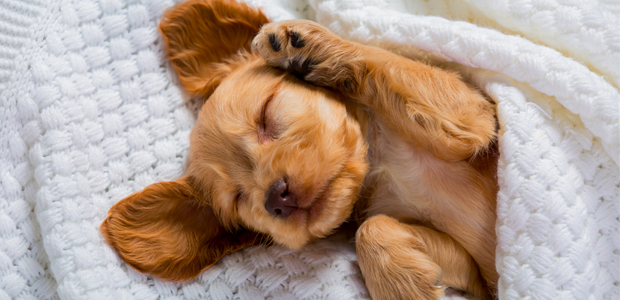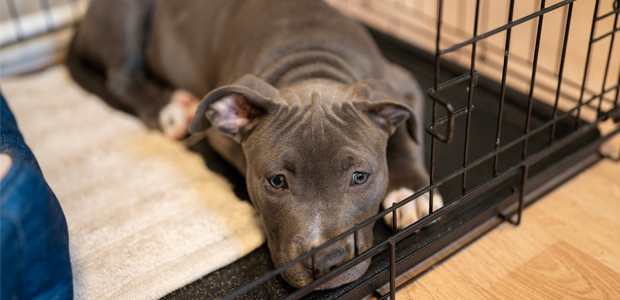Welcoming a puppy into your home is a really special feeling. After a big first day, it’s only natural to worry about how your new pup will get on in his first night in his new home.
We’ve spoken to leading animal behaviourist, Rosie Bescoby, to get the lowdown on how to get your puppy to sleep at night.
How much sleep do puppies need?
Puppies need lots of sleep. In fact, they will sleep for anywhere between 12-16 hours every day! Although that might sound like a lot, puppies are frequent nappers and will sleep throughout the day instead of saving up for a big sleep at night, like we do.
One of the main reasons your pup might wake you up is if they need to go to the toilet. Because of their small bladders, puppies can’t go for very long without needing to pee. As a rule of thumb, puppies can hold their bladder 1 hour for every month old they are (so a four-month old puppy can go about 4 hours without needing to go).
This isn’t always the case and you might find that your puppy can go the whole night without needing to go to the toilet from 8 weeks. However, it might also be the case that your pup needs to be let out several times a night for a good few weeks. Don’t be discouraged if this is the case, as puppies get used to things at different rates.
When you do get up in the night to take them outside, it’s a good idea to keep the experience as calm as possible and try not to engage in play, this will mean that your pup is more likely to settle back down as they get used to their sleep schedule.

My puppy is crying at night, what should I do?
Spending the night in new surroundings without their mother and littermates for company can be an overwhelming and lonely experience for puppies.
Because your pup won’t be used to spending time by itself, adjusting to sleeping alone can be upsetting for them. They might whimper or cry to start with, but thankfully there are a few things you can do to make them feel more comfortable in their new environment.
If you allow your puppy to sleep near you to start with, it should stop them from getting upset and crying at night. If your puppy does become upset or distressed, you will be close by to comfort them. It’s important that you don’t ignore your pup if they become upset.
Once they start to settle into their home and sleeping routine, you can gradually increase the distance between yourself and the pup.
Before your puppy comes home for the first time, it’s a good idea to create a dedicated area for them, a cosy space where they can feel safe and warm. Some people prefer to have their dog sleeping downstairs or in a separate part of the house, whereas other people like to have their dog sleep in the same room as them. The choice is personal and entirely up to you.
Read now: Bringing home a new puppy: the ultimate guide
Crate training a puppy at night
To begin with, you might find it a bit tricky to get your pup to sleep in a crate. Puppies are curious by nature and will sniff in and around their crate to explore their surroundings. To help coax your puppy into their crate, make it an inviting place filled with toys and soft blankets. Reward your dog with treats and praise when they go inside.
Dog’s love having their own den, a dedicated area just for them where they can feel secure. By creating a positive association with being inside the crate, you can get your puppy used to being on their own, reducing their chances of developing separation anxiety.
When it comes to choosing the right crate for your dog, the key thing to consider is size. Your puppy should have enough room to comfortably sit, stand, stretch, lay down and move around when they are fully grown.
The space needs to be secure and cosy, whilst being large enough to remain comfortable. Choosing a crate that is too large can make them feel unsafe.

Read Now: How to crate train a dog
When it’s time to settle in for the night, you can cover the crate with a towel or blanket to help them feel extra safe and secure. If you cover the bottom of the crate in blankets, your puppy will be less likely to have an accident inside the crate, because they don’t like to go to the bathroom in the same area that they sleep.
It can take time for your puppy to get used to the crate, but it’s important not to shut the door if they aren’t happy being inside. The door can be left open, this way if the puppy isn’t happy, they can come in and out as they get used to the space. It might even be the case that your pup prefers to sleep on a bed that is outside of the crate, which is fine.
If a crate isn’t working for you or your puppy, you might decide against using one. You might choose to set up a pen around the dog’s bed to create a secure environment that will prevent your puppy from wandering off. The most important thing is that your dog isn’t distressed and has a nice warm bed.
Need more info?
If you would like to know more about welcoming a puppy into your home, contact us to speak to our team of experts.